Spider Collector's Journal (34th page: 2024) Copyright © 2024 by Rod Crawford
Here's the 34th page of narratives of fun (and not so fun) trips to collect spiders for research at the Burke Museum, some accompanied by capable field volunteers: Laurel Ramseyer, Kathy Whaley and new recruits. Most also appeared in Scarabogram, newsletter of "Scarabs: The Bug Society." Dates of field trips head each paragraph. Maps showing the location of sites within Washington state follow the grid system outlined in the Washington Spider Checklist. RETURN TO INDEX
Where you see this button ![]() in a
field trip account, click it to get a page of collecting site photos!
in a
field trip account, click it to get a page of collecting site photos!
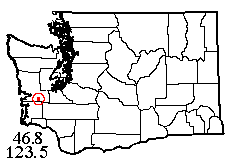 |
![]() 16 III 2024: At last, after waiting since Halloween, the year's first warm and dry days were in prospect! I had a plan in place and had applied for access permission to a small-scale landowner, Olympic Peninsula Timberlands, which rather surprisingly had a smooth, easy mechanism for that. Our goal was the vicinity of Vesta, a tiny community on the North River just across the Grays Harbor County line from the south. On the way, we stopped at a small "pioneer cemetery" outside Oakville, where a short visit bagged 13 species, and Laurel's grave-vases sample included Islandiana flaveola, a new state record! Vesta itself has an even tinier cemetery, boasting a single grave; there, ten species gave us a nice start on the new gridspace, as the day had become lovely and warm.
16 III 2024: At last, after waiting since Halloween, the year's first warm and dry days were in prospect! I had a plan in place and had applied for access permission to a small-scale landowner, Olympic Peninsula Timberlands, which rather surprisingly had a smooth, easy mechanism for that. Our goal was the vicinity of Vesta, a tiny community on the North River just across the Grays Harbor County line from the south. On the way, we stopped at a small "pioneer cemetery" outside Oakville, where a short visit bagged 13 species, and Laurel's grave-vases sample included Islandiana flaveola, a new state record! Vesta itself has an even tinier cemetery, boasting a single grave; there, ten species gave us a nice start on the new gridspace, as the day had become lovely and warm.
A short distance up North River Road (but not quite as obvious as expected) was the gated track into the OPT lands, obviously not in use by vehicles but easy enough to walk. I proceeded along this to where a small tributary crossed it, and beavers had created a nice little pond and marsh. Here, amid peace and solitude, alder/cottonwood litter was fairly productive and I sifted 6 spider species, including a male of one of Laurel's research subjects, Ozyptila pacifica. Laurel came along somewhat later and sifted moss on the trees, adding 8 more including 2 species that will need further study. My beating of fern understory and a couple of hemlock trees added a final 6 for the marsh site.
Back at the paved road, Laurel had pulled 9 species off a relatively new bridge across the North River, 4 of them adding to our sample, and 1 or 2 more additions off a mini water tower. In riparian meadows, I added nothing new from the grass but 3 more from small spruce trees. Sifting more moss near the bridge gave Laurel 2 more additions, and I added only one from some trees up a side road, making 39. A male Pardosa vancouveri that I took home to rear makes it an even 40, and Laurel is trying to rear 2 juvenile Phidippus from the bridge. (One of these later matured … after eating the other!)
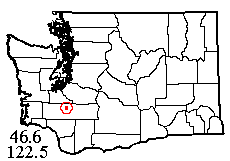 |
![]() 19 III 2024: The amazing end-of-winter warm spell had one day more to go, with Laurel not yet available, but I was able to recruit Kathy Whaley, enthusiastic newbie, again. Our goal: a place called Cinebar in central Lewis County, where I'd found a good tract of public-access-friendly Manke Timber land with a handy decommissioned road right up the middle.
19 III 2024: The amazing end-of-winter warm spell had one day more to go, with Laurel not yet available, but I was able to recruit Kathy Whaley, enthusiastic newbie, again. Our goal: a place called Cinebar in central Lewis County, where I'd found a good tract of public-access-friendly Manke Timber land with a handy decommissioned road right up the middle.
It was another balmy day. After getting a 13-species start from trees and understory near the highway, we hiked up the grassy old road (with a windfall here and there) until in something under a half mile, upper Stowell Creek crosses the road, with well developed riparian alder forest and some marshland. Pay dirt! And not a sign of other humans there through the day.
Sifting alder litter got me 9 species, and moss on some of the biggest alders added 9 more. Kathy had fixated on beating ferns, which got her 9 species but only one, Pocadicnemis pumila, we hadn't taken in other habitats. Afterward I swept the marsh (having to dodge some nasty cutleaf blackberry), adding 2 more. I had another nearby site to look at, so we moved on.
In hindsight, we should have stayed where we were; I could likely have scared up some dead wood or other habitats. The young forest I'd expected up August Road had mostly been logged recently, and signs warned us off other tracts. We ended up beating trees within the highway right-of-way, which added only one more species (Kathy got it, not I). Back at the original site, with time only for a quick trip to the upper reaches of the Manke trail, I added a final 2. Even so, a 36-species total isn't bad at all! Our trip home ran afoul of an accident-slowdown near Fort Lewis, but we made it OK with another gridspace taken care of.
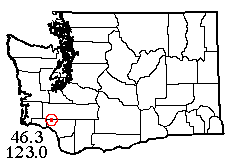 |
![]() 1 IV 2024: On April Fools' Day, Kathy and Laurel actually got together on the same trip! A warmer weather forecast sent us to Ryderwood Pond, the only public space (other than county roads) in the vicinity of Ryderwood, a small very secluded village whose population is all 55 and older! Did I say public? Signs imply that use of the pond (impounded by a dike-like dam), woods and trails is reserved for residents only, but the few we talked to didn't seem to mind visiting spider collectors. At first (after a stop on the way at Little Falls Cemetery), we thought we'd be restricted to one side of the pond due to a closed footbridge, but Laurel found another bridge at the other end so we were in!
1 IV 2024: On April Fools' Day, Kathy and Laurel actually got together on the same trip! A warmer weather forecast sent us to Ryderwood Pond, the only public space (other than county roads) in the vicinity of Ryderwood, a small very secluded village whose population is all 55 and older! Did I say public? Signs imply that use of the pond (impounded by a dike-like dam), woods and trails is reserved for residents only, but the few we talked to didn't seem to mind visiting spider collectors. At first (after a stop on the way at Little Falls Cemetery), we thought we'd be restricted to one side of the pond due to a closed footbridge, but Laurel found another bridge at the other end so we were in!
I began by sifting litter, getting only 3 identifiable species at the south end of the pond, but litter at the other end (still sparse) added 3 more. Kathy concentrated this time on conifer foliage with good results, getting 8 species including what looks like 2 different Grammonota. Laurel wandered about doing bits of this and that, sweeping Tetragnatha caudata from a marsh at the south end, finding a Tibellus on a cattail, tapping a few species (including a very interesting Walckenaeria) from Douglas-fir cones, getting Larinioides patagiatus in aerial webs, mature Pardosa vancouveri at the lawn edge, and three more species on a house across the street.
All three of us beat fern understory, making that the richest habitat with 12 species. Laurel hadn't brought her sifter; I lent her mine so we wouldn't be without her usual moss sample (added 4 more). The grand total of 34 was perfectly adequate, but lacked several common species that I really would have expected to find. One problem was that a good bit of the site's habitat was destroyed by blackberry; and there might have been more subtle degradations of habitat; still, not bad and an ultra-pleasant place to spend a spring day.
 |
![]() 13 IV 2024: An unfavorable forecast unexpectedly morphed into the prospect of perfect weekend weather, and better still both Laurel and Kathy were available again! Our destination was between the upper Middle and West Forks of the Satsop River, on timberland with access allowed by the Green Diamond company (thanks!). On the way in, we stopped at Tornow Cemetery (sampled more fully on Halloween 2021) so Laurel could add another locality to our study of the grave-vase spider. Soon after, we were on Cougar Smith Road (who was he, I wonder) and stopped at the gated Schafer Grade, prepared to hike along it to an area with a pond and a cool-looking wetland.
13 IV 2024: An unfavorable forecast unexpectedly morphed into the prospect of perfect weekend weather, and better still both Laurel and Kathy were available again! Our destination was between the upper Middle and West Forks of the Satsop River, on timberland with access allowed by the Green Diamond company (thanks!). On the way in, we stopped at Tornow Cemetery (sampled more fully on Halloween 2021) so Laurel could add another locality to our study of the grave-vase spider. Soon after, we were on Cougar Smith Road (who was he, I wonder) and stopped at the gated Schafer Grade, prepared to hike along it to an area with a pond and a cool-looking wetland.
A mile later, we arrived at the pond, peaceful home of a couple of wary ducks. I gathered a couple bags of alder litter from the slope above and settled down hopefully to sift. Curses, only 3 spider species plus a possibly identifiable spiderling! Meanwhile, Kathy had begun beating fern understory, bagging a solid 11 more (that's more like it). Laurel got 3 from salal but nothing different, then found 4 under bark scales of a Sitka spruce tree, adding a juvenile Trogloneta, and one more species sweeping near a stream. Both Laurel and I beat roadside western hemlock, for 12 species in all (adding 8). I collected some active Pardosa and Laurel later found a nice Poecilochroa columbiana scooting across the road. Laurel hadn't sifted any moss, so I did a couple of nice bags-full from alder trunks by the creek, for 9 species (adding 4), distinctly better than the litter. One more from bridge railings made 32 in all from the pond area.
Kathy had headed back to the car to nap, so Laurel and I hiked onward to see a wetland that looked bog-like on Google Earth. No such luck, it was half alder swamp and half very wet fen. Laurel did find a Misumena by a roadside trillium. Her spotting ability was really in gear, and on the way back to the car she added a nice female Larinioides orbweaver. I was hoping the habitats back by Cougar Smith Road could improve the quality of our sample, and my hopes were realized: litter there was distinctly better and added 4 more species. Laurel added two more from guardrails including a lovely male of Ceraticelus #2; and found a couple of good Hexura picea under rocks. We'd had splendid solitude on our hike, though back by the road a couple of chatty (but friendly) locals stopped by. Local horse-riders have developed a trail network, including the "Smelly Cow Trail" (must be a story there). Our final 41-species total is fully satisfactory.
 |
![]() 12 V 2024: A field-free month had passed with indifferent weather and broken teeth (one apiece) that needed time-consuming dental service. Today, Laurel had to cancel because the newly-repaired tooth was acting up, but Kathy and I decided to go anyway. Our destination was in a tract of Snoqualmie National Forest administered by Gifford Pinchot N.F. (both of which pretend it doesn't exist), but accessed by driveable, if unmarked roads. We successfully navigated to a bridge over the North Fork Tilton River (near the edge of a private inholding), where we didn't see another human all day. It was a lovely spot with riparian alder-cottonwood forest, some maple and conifers, and rich, varied understory.
12 V 2024: A field-free month had passed with indifferent weather and broken teeth (one apiece) that needed time-consuming dental service. Today, Laurel had to cancel because the newly-repaired tooth was acting up, but Kathy and I decided to go anyway. Our destination was in a tract of Snoqualmie National Forest administered by Gifford Pinchot N.F. (both of which pretend it doesn't exist), but accessed by driveable, if unmarked roads. We successfully navigated to a bridge over the North Fork Tilton River (near the edge of a private inholding), where we didn't see another human all day. It was a lovely spot with riparian alder-cottonwood forest, some maple and conifers, and rich, varied understory.
Leaf litter was present in quantity, and I sifted two full bags for 7 spider species, including a male of uncommon Oreonetides filicatus, an Ozyptila pacifica and quite a few Hexura picea. Siftable moss was sparse, but added 4 more. A few roadside conifers were reachable and Kathy did a good job of beating these (a good thing too, as it turned out), adding no less than 7 more species. She swept 3 more from roadside grass (including Crustulina sticta which you don't see every day), then found a sunny nest of tall grass and settled down there for a quiet nap! Meanwhile, I explored the other end of the bridge for a way down to an enticing gravel bar (no way was found), but did find a nice grassy glade where I got a few active Pardosa. Returning, I met Kathy refreshed by her snooze and we both beat fern understory, adding 4 more species for a site total of 25-26.
Being in the middle of a working forest, I had visions of beating at least 10 more species from planted conifers in a clearcut. So we spent the rest of our time cruising the nearby logging roads, searching for one! It looked like there were some just out of reach from the roads, but how to access them? Finally we stopped at a high switchback where a few more roadside conifers added 2 more species. More cruising finally brought us to brand-new clearcuts — not planted yet! Here, on a trail at road's end, I added another harvestman species but no new spiders, and then it was time to go home. However, 27-28 species is perfectly adequate, and our main site was quite a nice place with practically no invasive spider species at all.
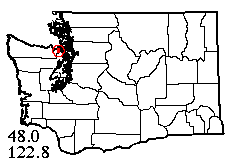 |
![]() 15 V 2024: Trying to make up a bit for lost time, I wangled another trip only 3 days after the North Fork Tilton one. This time Laurel but not Kathy was available, and with her tooth still settling in, Laurel wanted a lower impact trip, so I chose a destination on the Quimper (Port Townsend) Peninsula where much of the traveling was done by ferry. Despite missing a turn, we arrived at Cape George Road in reasonably good time, after a stop at a cemetery just outside Chimacum where Laurel got 5 good records (including uncommon Micrargus aleuticus) in the grave vases. We easily found our main goal, an overgrown side road (on public land) that brought us within brushwhacking distance of a wetland. Although we'd crossed from a red cedar forest into deciduous, leaf litter was extremely sparse and yielded only 5 spider species. But the understory was so obviously spider-rich that I decided to stay on site, beating, while Laurel bravely struggled on to the wetland.
15 V 2024: Trying to make up a bit for lost time, I wangled another trip only 3 days after the North Fork Tilton one. This time Laurel but not Kathy was available, and with her tooth still settling in, Laurel wanted a lower impact trip, so I chose a destination on the Quimper (Port Townsend) Peninsula where much of the traveling was done by ferry. Despite missing a turn, we arrived at Cape George Road in reasonably good time, after a stop at a cemetery just outside Chimacum where Laurel got 5 good records (including uncommon Micrargus aleuticus) in the grave vases. We easily found our main goal, an overgrown side road (on public land) that brought us within brushwhacking distance of a wetland. Although we'd crossed from a red cedar forest into deciduous, leaf litter was extremely sparse and yielded only 5 spider species. But the understory was so obviously spider-rich that I decided to stay on site, beating, while Laurel bravely struggled on to the wetland.
I spent perhaps an hour beating salal and fern, with good results: 14 species, most notably a lot of male Meioneta darrelli, which must just be maturing (all the males mature but no females yet). Then it occurred to me that I'd heard nothing from Laurel for quite a while. I looked at my cell phone, which amazingly had a minimal signal, so I called her. "Hi, are you lost?" "No, not lost." "OK, just checking." Then, ten minutes later the phone signals: could I yell towards the wetland to give her a direction for her struggle through the salmonberry? So I yelled Hello, alternating with Yo, and eventually heard a far-off answering call. Finally a familiar hat appeared between distant branches… Anyway, Laurel had found some nice habitats: a ring of grassy glades, some snags with loose bark, and inside that a cattail marsh with some open water. The grass added two species, one of them rare Erigone cristatopalpus. The bark, plus some aerial webs, added 7 more including a very off-season mature female Araneus nordmanni. A bag of moss she brought back to sift at the car (didn't bring any litter, darn) added a further 11 with both some moss usual-suspects and a couple of wetland specialists, making 34 spider species from this site, not a very extensive area despite the struggle to move around in it.
A very short drive beyond our main site, another blocked road (this one with a metal gate) beckoned on the other side of Cape George Road; this one led into an area logged a couple of decades ago, with access to adequate amounts of conifer foliage. I beat diverse conifers for an hour or so, taking 11 species (not including some I would have expected), while Laurel sifted her moss. Then we both swept the grassy gated road (never actually sighting each other in the process). We ended the day with 45 species from Cape George Road. It so happened I had two additional species from homeowners nearby and 6 more trapped by WSU grad students on a broccoli farm, so the end total is 53! This success far more than compensates us for Laurel's failure to find any grave vases at the cemetery outside Port Ludlow on our way home.
 |
![]() 30 V 2024: Both Laurel and Kathy were up for a long trip to central Grant County, so we headed straight east on I-90 to Exit 164 and the public access section of Winchester Lake (actually a wide spot in the Winchester Wasteway, drainage route for irrigation runoff). The site offered (treeless) riparian habitats and shrub-steppe with sagebrush and both species of rabbit brush represented, a nice change for all of us. Despite very pleasant weather, nobody but us visited the lake all day. I immediately began a riparian sweep sample, getting 9 species in all (to which Laurel added 2 more, one being a wholly unfamiliar female Philodromus). I had set Kathy to beating sagebrush, and she staunchly kept at it until she had 7-8 that were different. Laurel added 2 more from upland sweeping, and we both sampled plant-tip webs and retreats for 4 species, notably Laurel's two adults of uncommon jumping spider Pelegrina helenae on green rabbit brush.
30 V 2024: Both Laurel and Kathy were up for a long trip to central Grant County, so we headed straight east on I-90 to Exit 164 and the public access section of Winchester Lake (actually a wide spot in the Winchester Wasteway, drainage route for irrigation runoff). The site offered (treeless) riparian habitats and shrub-steppe with sagebrush and both species of rabbit brush represented, a nice change for all of us. Despite very pleasant weather, nobody but us visited the lake all day. I immediately began a riparian sweep sample, getting 9 species in all (to which Laurel added 2 more, one being a wholly unfamiliar female Philodromus). I had set Kathy to beating sagebrush, and she staunchly kept at it until she had 7-8 that were different. Laurel added 2 more from upland sweeping, and we both sampled plant-tip webs and retreats for 4 species, notably Laurel's two adults of uncommon jumping spider Pelegrina helenae on green rabbit brush.
I went down to the muddy shore at the boat ramp; on the way, I spotted a big Phidippus audax jumping spider on a short log, which jumped right into my net, right back out and vanished! Curses! But on the lake mud I managed to get two female Pardosa tristis wolf spiders, while Laurel found one P. moesta a little farther inland. Laurel got several repeat species on the posts and wires of a fence, and a nice Platycryptus jumping spider on the site's main sign. There was very little on the ground for spiders to hide under, but Laurel got a Schizocosa under one rock, a female Phidippus johnsonii under a dead sagebrush stem, and one uncommon theridiid and a totally unfamiliar dictynid under small boards; I found a Psilochorus population under pieces of a broken culvert. Before heading out, Kathy followed my suggestion to shake tumbleweeds (a "Western icon" that thrilled her) over her net, getting 3 species but nothing unusual this time. For this site, our total was 27 species.
A short way along our drive home, the freeway crosses the Wasteway farther south, adjacent to a rest area. There, beating rabbit brush I got Philodromus histrio while Kathy got the even better Tibellus gertschi. Laurel got Dictyna calcarata from the restroom building and two more additions from picnic-table windscreens (which I'd looked at before her without spotting anything). With 33 species in our vials, we were ready for the luscious reward of Mountain High Hamburgers in Easton!
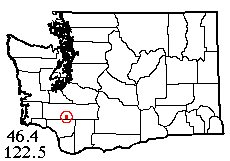 |
![]() 9 VI 2024: Time for another western Washington trip. The three of us traveled to Winston Creek (near a cluster of buildings called Winston) just into the Cascade foothills at the south edge of Lewis County. En route, we stopped at secluded Salkum Cemetery where Laurel got 3 species (including her target) from grave vases while I got 4 others from vegetation, a head start of 7 for the Salkum area. My preselected site at Winston Creek (some apparent meadows on state land) didn't work out, as there was a tributary creek (not visible in aerial photos) between us and the meadows, and the road crossing this creek turned out to be someone's driveway! So we jogged east to plan B, a campground a bit farther up Winston Creek. The entire campground is in a floodplain with intensely green, shady forest dominated by bigleaf maple and red cedar. Many campsites were occupied or reserved, but we found one at a trailhead where steps led about 20 feet up to a little plateau with a picnic table, spider collectors' Valhalla.
9 VI 2024: Time for another western Washington trip. The three of us traveled to Winston Creek (near a cluster of buildings called Winston) just into the Cascade foothills at the south edge of Lewis County. En route, we stopped at secluded Salkum Cemetery where Laurel got 3 species (including her target) from grave vases while I got 4 others from vegetation, a head start of 7 for the Salkum area. My preselected site at Winston Creek (some apparent meadows on state land) didn't work out, as there was a tributary creek (not visible in aerial photos) between us and the meadows, and the road crossing this creek turned out to be someone's driveway! So we jogged east to plan B, a campground a bit farther up Winston Creek. The entire campground is in a floodplain with intensely green, shady forest dominated by bigleaf maple and red cedar. Many campsites were occupied or reserved, but we found one at a trailhead where steps led about 20 feet up to a little plateau with a picnic table, spider collectors' Valhalla.
I carried up bags of maple litter from 2 places in the floodplain, while Laurel gathered bags of moss from nearby trees and we sifted at opposite ends of the table. Meanwhile, Kathy beat fern understory on the plateau, sorting through her net on what space remained in mid-table. I got 11 litter spider species, plus harvestmen and others; Laurel got only 5 species from moss (but including the Ozyptila she wanted). Kathy got a fine 19-species sample from the ferns, but I suspected ferns on the steep slopes below our plateau held even more, so I spent a little time beating them — and added 7 more, for 26 fern spider species! At this point we had 35 species from only 3 habitats.
Now we split up: Kathy to her nap, me to seek other habitats by the paved road and campground entrance, Laurel to find her way to the creek, which despite the seeming lack of a direct route, she managed. At the creek, there was a narrow beach of cobbles, shaded and too inaccessible to have been trampled by humans. Under the rocks were 4 good species, with another male Ozyptila out in the open. Nearby was a shady but grassy swale just upslope of the creek, where Laurel swept 6 species, three adding to the list. Meanwhile, I wasn't having such good luck at the camp entrance, but I swept considerable roadside grass, adding one more species. The few conifers and rocks I found there added nothing new. But overall, our total from this campground was 43 species! Two of the most interesting were the Agyneta perspicua and an unknown male Dictyna from my fern beat. A fine day in beautiful, quiet (despite campers nearby), ultra-green surroundings.
 |
![]() 22 VI 2024: I'd been wanting to return to Mission Ridge Ski Resort (south of Wenatchee) to sample the higher elevation areas we hadn't had time to hike to last year, but on suitable days there was always some rain chance. Finally, perfect conditions! It sure takes a long time to get there, and it was well into the afternoon when we reached our goal, at 5200' halfway up the ski run to the ridge crest (all of us puffing a bit on our first serious climb of the season). No snow near our site. I set Kathy to turning rocks by Squilchuck Creek, and she got one excellent adult Callobius nevadensis (the only live one we found). She had less luck (oddly enough) from conifer foliage, but did get some good species from sweeping under the trees. I went direct to the conifers at the far side of the ski run, and had very good luck, getting 10 good species (some from trees at the near side), including rarities and a well-above-average diversity of Theridiidae. Grass in the ski-run clearings got me 2 additional species, with a nice bright yellow Misumenops from Arnica flowers.
22 VI 2024: I'd been wanting to return to Mission Ridge Ski Resort (south of Wenatchee) to sample the higher elevation areas we hadn't had time to hike to last year, but on suitable days there was always some rain chance. Finally, perfect conditions! It sure takes a long time to get there, and it was well into the afternoon when we reached our goal, at 5200' halfway up the ski run to the ridge crest (all of us puffing a bit on our first serious climb of the season). No snow near our site. I set Kathy to turning rocks by Squilchuck Creek, and she got one excellent adult Callobius nevadensis (the only live one we found). She had less luck (oddly enough) from conifer foliage, but did get some good species from sweeping under the trees. I went direct to the conifers at the far side of the ski run, and had very good luck, getting 10 good species (some from trees at the near side), including rarities and a well-above-average diversity of Theridiidae. Grass in the ski-run clearings got me 2 additional species, with a nice bright yellow Misumenops from Arnica flowers.
Laurel had been ranging over a somewhat bigger area, hitting other habitats, and got 2 species ground-active, 4 on buildings, 2 under dead wood, and a rather better under-rock sample (she must have found a better patch of rocks), that included a male Xysticus crab spider I don't recognize at all. She also added the common flower crab spider from elderberry foliage.
Understandably impatient to get going for her distant home, Kathy had returned to the car and Laurel and I reluctantly followed (not as fast as Kathy would have liked!) We made one stop to sift Douglas-maple litter (nothing worthwhile there) and tap pine cones (which added the pine cone spider Euryopis formosa). 'Twas a long day with relatively short time to collect, but we got 25 species (including good ones) and don't have to do that trip again, hooray!
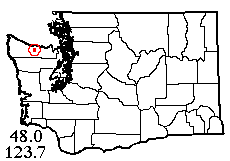 |
![]() 28 VI 2024: We'd used my last trip plan involving the Kingston ferry, so I made a new one (and promptly used that too!). The destination was low-elevation (1000') national forest land just south of Lake Sutherland, using a road shown on the Forest Service map, topo map and Google Earth. You can guess what's coming, right? Kathy, Laurel and I cruised along the south shore of the lake without initially finding the road. We finally concluded an unmarked dirt track must be it. Well under a mile up this, it was gated! A similarly short walk up the gated part and it became a trail at a tank trap. Fortunately, not too far up the trail (in pleasant, almost-cool weather) we came to a lush, lovely spot that was far enough into our grid-area to collect. There was a little grassy clearing, some reachable conifer foliage, fern and salal understory to beat, and a stand of mature conifer forest with dead wood!
28 VI 2024: We'd used my last trip plan involving the Kingston ferry, so I made a new one (and promptly used that too!). The destination was low-elevation (1000') national forest land just south of Lake Sutherland, using a road shown on the Forest Service map, topo map and Google Earth. You can guess what's coming, right? Kathy, Laurel and I cruised along the south shore of the lake without initially finding the road. We finally concluded an unmarked dirt track must be it. Well under a mile up this, it was gated! A similarly short walk up the gated part and it became a trail at a tank trap. Fortunately, not too far up the trail (in pleasant, almost-cool weather) we came to a lush, lovely spot that was far enough into our grid-area to collect. There was a little grassy clearing, some reachable conifer foliage, fern and salal understory to beat, and a stand of mature conifer forest with dead wood!
I got only one species from the grass, but Kathy beat a nice 13 from the low conifer foliage (plus the trip's one mature harvestman), with few crab spiders but lots of Pityohyphantes. Both Laurel and I beat salal for 8 species and ferns for 12 (featuring a male of rare Dipoena daltoni). Laurel added one species from Douglas-fir cones and the two of us sampled dead wood (smaller chunks for me, bigger slabs for Laurel), getting 4 species plus some Calymmaria that unfortunately were all juvenile. Meanwhile, Kathy took her afternoon nap.
Laurel ended our day by sifting moss, and I tried the litter of one isolated maple tree. Between us, our sifting added only 5-6 species. The grand total was 28-29. I guess the season is starting to get late for low elevation collecting — either that or this luscious-looking site just happened to have lower diversity. Although there appeared to be plenty of mosquitos around, they showed practically no interest in biting until we were nearly done. No other humans were using the trail today. Our return to the car was uneventful; we stopped at Mt. Angeles Cemetery just east of Port Angeles (Laurel and Kathy got 2 species from vases); and neatly caught a ferry with minimal waiting.
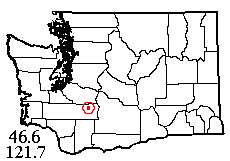 |
![]() 12 VII 2024: We'd suspended field work for a couple of weeks due to a world-class heat wave. It finally showed signs of abating, so Laurel and I (with Kathy out of town) headed for a hoped-to-be-cool forest site in the mountains. It was actually still pretty warm, but bearable. Unfortunately, while we took time off, the habitats stayed out in the hot sun, drying! We easily navigated to the Skate Creek Road and a side road up tributary Johnson Creek, which still had plenty of water. I swept 4 species from roadside grass, beat 7 from roadside conifers and 6 from roadside ferns. Laurel added one wolf spider species under a roadside rock, added two under streamside rocks, one from a Douglas-fir cone, and found a very interesting Hahnia on a stream boulder. My sifting of litter added only one species, Laurel's moss-sifting only two. This first site did bring us the basic minimum sample of 21 species.
12 VII 2024: We'd suspended field work for a couple of weeks due to a world-class heat wave. It finally showed signs of abating, so Laurel and I (with Kathy out of town) headed for a hoped-to-be-cool forest site in the mountains. It was actually still pretty warm, but bearable. Unfortunately, while we took time off, the habitats stayed out in the hot sun, drying! We easily navigated to the Skate Creek Road and a side road up tributary Johnson Creek, which still had plenty of water. I swept 4 species from roadside grass, beat 7 from roadside conifers and 6 from roadside ferns. Laurel added one wolf spider species under a roadside rock, added two under streamside rocks, one from a Douglas-fir cone, and found a very interesting Hahnia on a stream boulder. My sifting of litter added only one species, Laurel's moss-sifting only two. This first site did bring us the basic minimum sample of 21 species.
I hoped to reach a higher elevation site on Skate Mountain, and we took a chance on a shortcut up road 5240, which seemed like a nice direct route to Silver Creek Pass if it was driveable. Well, it turned out to be in very good shape until, with more than a mile to the pass, there was one spot the car couldn't handle. So, try, try again: down road 52 toward Packwood until we came to Road 47, in unknown condition, that headed where I wanted to go. Surprise, it was paved! We got to my Willame Creek site (almost went too far, the road was so easy) but even 1000' higher it was still dry; we did manage to add 4 species. On the way back to Road 52 we stopped where our side road crosses Skate Creek itself. Very dry, even down in the canyon, but we added 2 more species there for 26 total, making 27 with one older record.
Being now within striking distance of Packwood, Laurel wanted to sample the cemetery there. A glance at the map made me think it was even in our main sample area, but alas, no. However, in a short time we got a head start there of 8 species from 2 habitats. Having driven south to the west of Mt. Rainier, we went home up the east side of the Mountain, descending in Enumclaw where we stopped for good views both of Rainier and a couple of unexpected hot-air balloons at sunset, before continuing home.
 |
![]() 25 VII 2024: Reasonable weather and Kathy had both returned, and we planned a coastal trip (there being a rain chance at my preferred mountain destination). But Laurel had hinted she'd like to visit St. John's Cemetery in the Wishkah River valley, also not far from the coast, and I managed to come up with a trip plan in the mere hour of time available. We arrived at this rural cemetery with no hitches, and it proved what one might call a full-spectrum spider habitat site! Included were the grave-vases that had attracted Laurel, and which produced 4 species for her including the unnamed "Lepthyphantes #8" we are studying. A stand of not-too-old planted Douglas-firs on the west side had a lush understory, and some immensely productive conifer foliage reachable on the outer trees; the south border of the cemetery was a solid stand of lush salal, and these 3 habitats produced 20 spider species in all.
25 VII 2024: Reasonable weather and Kathy had both returned, and we planned a coastal trip (there being a rain chance at my preferred mountain destination). But Laurel had hinted she'd like to visit St. John's Cemetery in the Wishkah River valley, also not far from the coast, and I managed to come up with a trip plan in the mere hour of time available. We arrived at this rural cemetery with no hitches, and it proved what one might call a full-spectrum spider habitat site! Included were the grave-vases that had attracted Laurel, and which produced 4 species for her including the unnamed "Lepthyphantes #8" we are studying. A stand of not-too-old planted Douglas-firs on the west side had a lush understory, and some immensely productive conifer foliage reachable on the outer trees; the south border of the cemetery was a solid stand of lush salal, and these 3 habitats produced 20 spider species in all.
In the cemetery itself, I got 2 species from shrubs in some naturally-vegetated mounds scattered among the graves. Laurel added 2 more species from the wire fence and 2 others inside traffic cones! Douglas-fir cones, though far smaller than the traffic cones, added one further, making 31 in all from this first site.
About 4 miles to the north, a public land tract (one of those once called "wildlife recreation areas" — where the deer and the antelope play?) offered a gated dirt road passing through big grass fields (leased for hay cutting), a major woodland tract, and ending at the Wishkah River. At road's end, I and Laurel swept grass for 7 species, and Laurel edged through the blackberry to the river gravel bars (below crumbly mudstone cliffs); the rocks added 7 species not taken elsewhere. Moss and litter added 2 each, and Kathy (after a nap in the grass) got a nice male Hyptiotes from ferns and 2 more species from conifers back at the gate. Our grand total of 48 species is amazing for a late-summer trip!
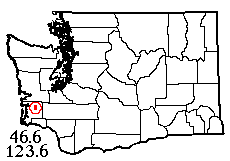 |
![]() 4 VIII 2024: With Kathy out of town, I held out the promise of an especially big cemetery to entice Laurel to the far reaches of central Pacific County. It didn't hurt that the forecast was for dry but cool! We took the southern route via I-5, Pe Ell and State Route 6, passing Pluvius and Lebam (both sites of future field trips) and soon arriving at Menlo. A half mile past the town, a left turn took us up the hill to extensive Fern Hill Cemetery (not to be confused with one of the same name in nearby Aberdeen). Driving to the upslope edge of the graves, we had an impressive view of the Willapa River valley, while behind us was a nice woodland tract (part conifer, part alder neatly divided by an overgrown dirt road) on cemetery property.
4 VIII 2024: With Kathy out of town, I held out the promise of an especially big cemetery to entice Laurel to the far reaches of central Pacific County. It didn't hurt that the forecast was for dry but cool! We took the southern route via I-5, Pe Ell and State Route 6, passing Pluvius and Lebam (both sites of future field trips) and soon arriving at Menlo. A half mile past the town, a left turn took us up the hill to extensive Fern Hill Cemetery (not to be confused with one of the same name in nearby Aberdeen). Driving to the upslope edge of the graves, we had an impressive view of the Willapa River valley, while behind us was a nice woodland tract (part conifer, part alder neatly divided by an overgrown dirt road) on cemetery property.
Laurel ranged around getting vase spiders, puffing a bit on the steep slopes but harvesting 6 nice species, none duplicated elsewhere. I began by sweeping tall grass along the woodland edge, later finding a fine grass field in a sort of embayment of the woods; this gave me 7 species. Along one side of the grounds, the tall Douglas-firs had some hanging branches I could beat, and this foliage was almost too full of spiders, mainly juvenile erigonine micro-spiders but with an adult here and there; 9 or 10 species in all. Laurel added 2 more from fallen cones with a third crawling among them, and 3 more on fences and a building. Fern understory, mixed leaf litter and alder trunk moss all made their contributions, and we already had 39 species when we left Fern Hill for sites in the valley below.
Stopping on Mill Creek Road at a gate leading into a square of public forest, I found some higher quality (in appearance) alder litter, but it only added one definite new record. I beat conifers across the road; Laurel swept a lot of forest grass and turned over a pile of dumped tires; each of these added one more. Back the way we came (by the Willapa River where Mill Creek joins it) was a goodly area of riparian meadows, unfortunately punctuated by monster blackberry thickets. The un-blackberried parts were lovely diverse meadows, but in the hour before our departure deadline, I only managed to add two more species. Still, we certainly can't complain about a grand total of 45 in the lowlands in August!
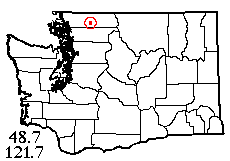 |
![]() 16 VIII 2024: For three years I'd been trying to get to the Marten Lake area, northwest of Baker Lake on the lower skirts of Mt. Baker, and something always stood in the way. Today we had cool non-rainy weather and Kathy's SUV to tackle Forest Road 1130 (which has potholes upon potholes), so we went for it! And was Laurel happy that her Prius was spared this torment. Anyway, about halfway up the 7.3 miles of bad road it improved in quality, and we arrived intact at where the topo map showed a branch track in the direction of the lake. No sign of the track. Despite the overcast with ceiling about two tree-heights above us, vegetation was just about dry enough to sweep, so Kathy and I started sweeping the daisy-dominated roadside verge, for a satisfactory 6 species.
16 VIII 2024: For three years I'd been trying to get to the Marten Lake area, northwest of Baker Lake on the lower skirts of Mt. Baker, and something always stood in the way. Today we had cool non-rainy weather and Kathy's SUV to tackle Forest Road 1130 (which has potholes upon potholes), so we went for it! And was Laurel happy that her Prius was spared this torment. Anyway, about halfway up the 7.3 miles of bad road it improved in quality, and we arrived intact at where the topo map showed a branch track in the direction of the lake. No sign of the track. Despite the overcast with ceiling about two tree-heights above us, vegetation was just about dry enough to sweep, so Kathy and I started sweeping the daisy-dominated roadside verge, for a satisfactory 6 species.
Meanwhile, Laurel ranged around as usual, finding 2 species under roadside rocks and eventually penetrating beyond the roadside to a treeless area, sort of a meadow but vegetated with tall shrubs and herbs. Across this went a rough trail, more or less where the map showed that phantom vehicle track, but with no sign of ever having been one. Here she got spiders from the shrubs, conifers, a log and a snag. Beyond the shrub "meadow," past a band of trees, she amazingly found a small but classic Sphagnum bog! Here the trail began to grow fainter, and more or less petered out on reaching a stream where the gravel bar rocks added one species. I had tried sifting roadside willow litter, adding only one species (but a good one); Laurel guided me to her bog where I added three more by sifting Sphagnum, including bog-loving Cybaeopsis wabritaskus. Dead wood in the nearby forest had a few spiders, including a mature Cybaeus.
Kathy and I spent much of the latter part of the day beating roadside conifers, for 13 species in all, including quite a number of little Dictyna. We never got near the lake (that was never more than a possibility anyway), but managed a grid-area total of 26 species, and need never jounce over those potholes again!
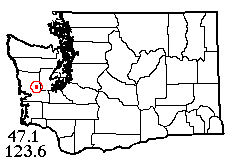 |
![]() 1 IX 2024: Sunday of Labor Day weekend looked like field weather, but my planned driver was out of the country. By a lucky chance, that week I met with Chris Snyder, new to the Burke Museum PR team, who wanted to document a spider collecting trip for the museum's social-media accounts. It turned out he was available Sunday! So I conjured up another near-coastal trip plan and off we went to the upper Wynoochee Valley, upstream of the area Kathy and I sampled last Halloween. Chris, besides driving, came fully equipped to document all the collecting with photos and video. My first planned stop was a Green Diamond parcel within an oxbow of the river, accessed (according to their map) by a familiar company gate. However, as we passed what seemed to be the correct gate, it had a private sign on it and several people clustered around. Uncertain what this meant, we drove a little farther and found an inconspicuous, gateless road on the east (away from the river) side of the highway, leading into a younger, perhaps 25-30 years since harvest, but still attractive second growth tract with no other people in it. I had Chris stop at a point where conifer, alder and understory habitats were all available.
1 IX 2024: Sunday of Labor Day weekend looked like field weather, but my planned driver was out of the country. By a lucky chance, that week I met with Chris Snyder, new to the Burke Museum PR team, who wanted to document a spider collecting trip for the museum's social-media accounts. It turned out he was available Sunday! So I conjured up another near-coastal trip plan and off we went to the upper Wynoochee Valley, upstream of the area Kathy and I sampled last Halloween. Chris, besides driving, came fully equipped to document all the collecting with photos and video. My first planned stop was a Green Diamond parcel within an oxbow of the river, accessed (according to their map) by a familiar company gate. However, as we passed what seemed to be the correct gate, it had a private sign on it and several people clustered around. Uncertain what this meant, we drove a little farther and found an inconspicuous, gateless road on the east (away from the river) side of the highway, leading into a younger, perhaps 25-30 years since harvest, but still attractive second growth tract with no other people in it. I had Chris stop at a point where conifer, alder and understory habitats were all available.
I made a nice start by beating western hemlock foliage (some in shade, some facing a small glade) and got 2 harvestman and 10 spider species, including a Cyclosa unexpectedly mature past the usual season. Some orb webs were around the glade, but the one we got was invasive Metellina segmentata (however, I later found native M. curtisi still surviving in the ferns). I beat 5 species from salal, adding 2 to the total; and 7 from ferns, adding another 2. Some of the alders, plus an unexpected large spruce tree, bore productive moss that yielded 6 more spider species (including another Ozyptila pacifica record for Laurel) and 3 more harvestmen. But the alder litter was disappointing, so I decided to move on to a second site; as it turned out, we already had 22 species.
Farther up the highway (as I'd ascertained from Street View) were more recent clearcuts planted with Douglas-fir. At a convenient pullout, I beat that rich foliage for 40 minutes or so and added no less than 10 additional species. Across the road, the planted trees started farther back, leaving room for grassy field habitat (unfortunately with some cutleaf blackberry). Grass-sweeping added 3 more species, including a prize catch, both sexes of rarely seen Neoscona arabesca. Some Scots broom also had the usual Theridion simile on it.
Now for the last site, where some evidence seemed to suggest a state boat launch! No sign at all on the narrow dirt road between farms, but the county web site did show it as a public right of way, so we persevered and were rewarded by one of the most beautiful public river access sites I've ever seen. Situated in a floodplain forest of big bigleaf maples, I easily loaded my leaf bag full of maple litter from a sort of wooden crib, and sifted it on the car, adding 5 spider species (much better than that alder litter). No riverbank grass was accessible, but I swept some on a gated road, for two introduced orbweaver species. Checking the outhouse for house spiders, I unexpectedly found a much bigger orbweaver (big enough to tweak Chris's latent phobia) under the eaves. Back at the lab, I found this spider and her smaller cousin to be another major bonus: native Araneus marmoreus, which I haven't seen in the field in years! Now the light was getting dim, thanks in part to a heavy overcast that blew in cooling the temperature and eliminating any chance of a sunset. We headed for home, making a tasty stop at Smitty's In-and-Out in Elma. This serendipitous trip got me at least 40 species!
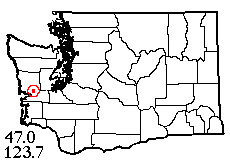 |
![]() 29 IX 2024: Thanks to journeys and illnesses, I had no drivers for most of September. But finally Kathy and Laurel were back in action, and after a cemetery stop in Elma, we aimed for Mooney Creek, a tributary of the lower Wynoochee on Bascom Pacific timberland. The road gate welcomed pedestrians and we hiked to our destination with no wrong turns. But it turns out that contrary to what Google Earth said, the route down the stream ravine was not a real road but a pipeline right-of-way, surprisingly steep; and the ravine unexpectedly deep! However, we all made it safely to the creek.
29 IX 2024: Thanks to journeys and illnesses, I had no drivers for most of September. But finally Kathy and Laurel were back in action, and after a cemetery stop in Elma, we aimed for Mooney Creek, a tributary of the lower Wynoochee on Bascom Pacific timberland. The road gate welcomed pedestrians and we hiked to our destination with no wrong turns. But it turns out that contrary to what Google Earth said, the route down the stream ravine was not a real road but a pipeline right-of-way, surprisingly steep; and the ravine unexpectedly deep! However, we all made it safely to the creek.
Laurel began by sweeping herbage along the creek, and made a magnificent catch: ultra-rare Pacifiphantes magnificus, which has never been collected in my presence before! I was sifting alder litter, and continued through 4 bags-full and 9 spider species, following that with fern understory for 6. Through all this, I saw no sign of Laurel, but her pack was there and I assumed she was back in the woods. Kathy had ascended back up to upland habitats along the road we'd hiked, and I was getting ready to do the same when Laurel called from high above! She had climbed a precarious route to a high clearcut beyond the ravine, with very worthwhile results, but hadn't yet sifted alder trunk moss, so I left her to do that (for 9 species).
That 2020 clearcut perched high above the south side of Mooney Creek was very interesting. The owners had planted western hemlock, not the usual Douglas-fir, and Laurel thought she'd gotten very little from beating it, but it was actually a nice 8-species catch. Sweeping the fern-shrub-herb "meadow" was also productive, and the ground surface produced interesting records of Castianeira longipalpa and Habronattus oregonensis.
At my roadside site on the north lip of the ravine, I swept 6 species from grass and beat 7 from salal; when Laurel rejoined me after her moss sift and climb out of the depths, she beat the larger hemlocks for 5 species, but none different from those in other habitats. Kathy, whom we rejoined back at the car, had added one more from conifers and a nice male Tarentula kochii (besides harvesting a bag of chanterelle mushrooms). 41 species in all, including that great record of P. magnificus!
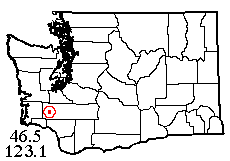 |
![]() 7 X 2024: Kathy was due to be out of the country, with time for one more spider trip; she, Laurel and I headed south to Lewis County and the community of Boistfort (sometimes pronounced Baw Faw). The place boasts two cemeteries, only one in current use; from that one we gathered a nice 11 species. The older (pioneer) cemetery has an interesting site (atop a peculiar mound raised some 50 feet above the surrounding plain which is called Boistfort Prairie); and a just-as-interesting history!
7 X 2024: Kathy was due to be out of the country, with time for one more spider trip; she, Laurel and I headed south to Lewis County and the community of Boistfort (sometimes pronounced Baw Faw). The place boasts two cemeteries, only one in current use; from that one we gathered a nice 11 species. The older (pioneer) cemetery has an interesting site (atop a peculiar mound raised some 50 feet above the surrounding plain which is called Boistfort Prairie); and a just-as-interesting history!
It had been in use for 32 years when, in 1887, a new property owner all but destroyed it, intending to grow crops there, but was stopped by a court order just after the nick of time, with all the gravestones knocked down and piled up. The place was barred to the public for many years, but finally in 1982 the local Lions Club got permission to clean it up and make it presentable. Alas, they didn't keep up the good work; a blackberry thicket has swallowed their access stairs and half of the cemetery plateau, but there is still a faint trail that let us reach the top of the mound and access a little tall grass, one big Douglas-fir, some snowberry and feral apple trees. Here we swept 6 species from grass, Kathy got 2 others from the fir tree, and Laurel found some unusual moss growth at the base of snowberry stems that yielded 4 species not taken elsewhere, including a series of Helophora reducta with two very atypical males!
Now we moved on to a more successful project of the local Lions: a woodland park on land leased from Weyerhaeuser, with a clearing, cedar and alder stands, and nice big mossy maple trees along Slide Creek which runs through the tract. My first concern at Boistfort Lions Public Park was to sift maple litter, but it was uncharacteristically disappointing, with only 5-6 spider species. Kathy got 4 species from cedar foliage and I added 3 more from a few accessible bits of Douglas-fir. Fern understory was much better with 11, and Laurel sifted an excellent 20 from moss, including a Spirembolus I don't recognize. On a roll, Laurel also got a good sweep sample along the creek and 4 good species under streambank cobbles. Kathy took some of the best spiders of the day from a stand of young Douglas-fir just west of the park, including strangely-shaped Tmarus angulatus and Rhomphaea fictilium. Where we'd parked just to the east, Laurel got two more from Douglas-fir cones; our grand total was a splendid 56 species!
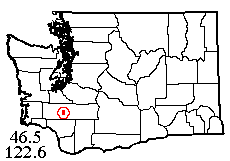 |
![]() 13 X 2024: With Kathy gone, Laurel and I took advantage of another beautiful fall day to complete the sample we'd made a head start on back in June at Salkum Cemetery in the Cowlitz Valley. I'd selected three nearby sites, beginning with a river access site, owned by the City of Tacoma, just below a small "barrier dam." A lot of blackberry didn't leave us many options for penetrating the forest beyond the parking lot and access road; but I was able to reach some decent maple-cottonwood litter to sift while Laurel sifted tree trunk moss. Our sifting alone brought us 22 spider species, some of the litter species decidedly rare. After this, we went our separate ways to sweep grass and seek other habitats…
13 X 2024: With Kathy gone, Laurel and I took advantage of another beautiful fall day to complete the sample we'd made a head start on back in June at Salkum Cemetery in the Cowlitz Valley. I'd selected three nearby sites, beginning with a river access site, owned by the City of Tacoma, just below a small "barrier dam." A lot of blackberry didn't leave us many options for penetrating the forest beyond the parking lot and access road; but I was able to reach some decent maple-cottonwood litter to sift while Laurel sifted tree trunk moss. Our sifting alone brought us 22 spider species, some of the litter species decidedly rare. After this, we went our separate ways to sweep grass and seek other habitats…
And then it happened! I sat down on a log jammed against a tree trunk to sort a sweep sample, and the log instantly broke, catapulting me (unhurt) to the ground, with my glasses flying an undetermined distance and direction off into the unknown! I wasted considerable time searching for them, handicapped by inability to see more than a foot away, but finally had to admit I needed help. So I could find the right tree again, I leaned my net against it, and wandered about hoping to find a spot with phone service, which after a while I did. Laurel, summoned from her successful sweep, came to help me search, initially with no better success. Finally she found them where they'd buried themselves in leaf litter that she had to kick aside! By this time, we felt we had to move on to our forest site, but we did have 29 species from the riverside (the outhouse also contributed).
A forest tract (diverse second growth with rich understory) owned by good old Manke Timber featured a semi-overgrown gated road where we only had to stroll a quarter-mile to reach plenty of habitat. My beat samples from salal and ferns added 7 species, an aerial web had a plump mature Araneus, and Scots broom had others. Laurel sifted moss from well-draped young cottonwoods, while I brought a bag of litter from the same stand home to sift. This brought us well over 40 species. The last site, with the sun sinking, was a tree farm stand, unfortunately well-blackberried, but we managed to reach enough Douglas-fir foliage to bring the day's catch to a nice even 50, making 56 with the cemetery sample from June; an ultra-productive day!
 |
![]() 7 XI 2024: It's not every year that we get a lovely weather forecast in November, but it was due to be ideal for just one day; amazingly, Laurel, Kathy and even Jerry Austin were all available that day! We went to Lebam (Mabel spelled backward) in Pacific County, where there's a good-sized cemetery and (just across the road) a stretch of the Willapa Hills Trail that crosses the Willapa River. As we pulled into Maple Hill Cemetery, my eyes lit up at the wide expanse of accessible Douglas-fir foliage. I beat a few of the trees myself, in intervals of warming (on the car's hood) and sifting maple litter, and Kathy beat more. Unknown to us, Jerry also decided to concentrate on that same habitat and filled at least 5 vials with tree-beatings! But none of the effort was wasted; these trees were so rich that we all got species the others didn't, 40 in all, probably a record for a single habitat; my litter sift made it 47!
7 XI 2024: It's not every year that we get a lovely weather forecast in November, but it was due to be ideal for just one day; amazingly, Laurel, Kathy and even Jerry Austin were all available that day! We went to Lebam (Mabel spelled backward) in Pacific County, where there's a good-sized cemetery and (just across the road) a stretch of the Willapa Hills Trail that crosses the Willapa River. As we pulled into Maple Hill Cemetery, my eyes lit up at the wide expanse of accessible Douglas-fir foliage. I beat a few of the trees myself, in intervals of warming (on the car's hood) and sifting maple litter, and Kathy beat more. Unknown to us, Jerry also decided to concentrate on that same habitat and filled at least 5 vials with tree-beatings! But none of the effort was wasted; these trees were so rich that we all got species the others didn't, 40 in all, probably a record for a single habitat; my litter sift made it 47!
Meanwhile, Laurel wasn't idle. She found only 6 of the recessed grave-vases but they added 4 more species including the undescribed lepthyphantine we're studying. Across Robinson Road was the Willapa Hills Trail, as usual traversing productive habitats; sifting tree trunk moss there gave her 16 species. Somewhat farther west the trail crosses the Willapa River on an ex-railroad bridge, where sweeping grass and herbs along the river; sorting big wads of flood debris caught in tree branches during high water; and picking spiders off the bridge, added several more. Toward dusk, I beat ferns and bracken in upland forest, adding Ceraticelus fissiceps. Our grand total for the day, all within a short walk of the cemetery, was an amazing 63 species!
Naturally, such a big collection includes a number of interesting records. Two pirate spiders were present, native Ero canionis (Jerry and Laurel) and introduced E. tuberculata (Kathy and me). There seem to be no less than 5 Linyphantes species, including a black one (Jerry's sample) I don't recognize. The conifer foliage produced a number of Phanias albeolus jumping spiders, some males, some regular females, and some decidedly odd females (mostly in Kathy's sample) that just might be something new; further study needed! The November sun set while we were still on site, and yellow and red phases duly recorded (see album). Home safe with no serious adventures.
And now the steady rains are back, but we still expect to get out again next year!
This page last updated 21 March, 2025